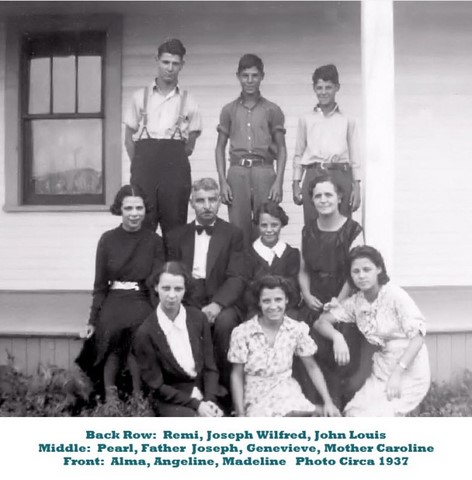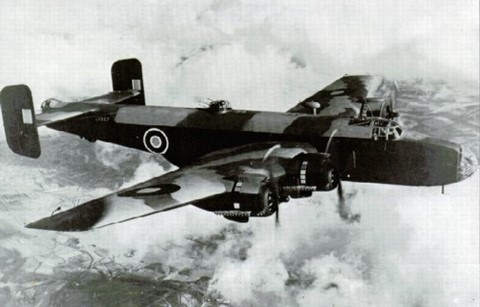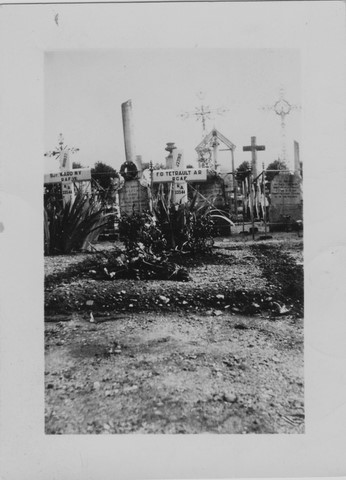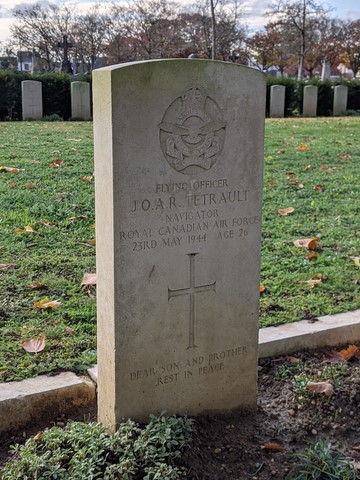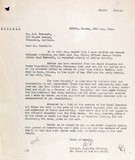Remi and Joseph-Wilfred Tetrault :
The Sacrifice of two Canadian Airmen By Josée Tétreault
Remi and the Royal Canadian Air Force
On September 17, 1940, in Winnipeg, Remi Tetrault joined the Royal Canadian Air Force. He was then living in Transcona, Manitoba, where he had been working for five years as a sheet metal worker at the Canadian National Railway.
Remy began his training in various schools in Ontario. He trained in military discipline while learning the basics of aviation and the use of weapons. In the Summer of 1942, after serving 22 months as a mechanic, Remi is recommended to serve as navigator. He enrolled at the Initial Training School in Belleville and then, in October, at the Air Observer School in London where he obtained the necessary training to become a navigator. On February 19, 1943, he was promoted to sergeant and was awarded his navigator’s license
England
In early March 1943, Remi was sent to Halifax, where he boarded a ship for England on March 19.
On his arrival, Remi continued his training. He had the knowledge, but now needed to gain experience. He was first assigned to the Advanced Flying Unit # 3 in Bobbington and then to an Operational Training Unit # 23 at Atherstone. In February and March 1944, two weeks of training at the Dalton Combat School and then at Topcliffe enabled him to complete his training. In mid-March 1944, Remi Tetrault joined the 425th Canadian Bombing Squadron.
Crash of the Halifax LK810
On the night of May 22 to 23, 1944, Remi and his companions boarded the Halifax LK810. Flying Officer Tetreault's navigator station occupied the forward section of the fuselage at the lower level. A metal partition separated him from the radio operator. The radar navigation equipment took up most of the space, so the area was tight.
The crew of this aircraft took part in the Transportation Plan. The plan, drawn up in January 1944, aimed to destroy the railway infrastructures in France, Belgium, and West Germany. In anticipation of a next landing in the north of France, the Allies wanted to prevent the Germans from transporting material and reinforcements to the Normandy coast. This plan had started the preceding March 6th.
The plane took off from the base at Tholthorpe, Yorkshire, at 00h10. The mission of the crew: to destroy the marshalling yard of Le Mans in France. No less than 133 aircraft took part in this bombing.
Hercule, a resident of Monce-en-Belin, a small village about fifteen kilometers south of Le Mans, recounts:
On this night of May 22-23, our little village of Monce-en-Belin was calm, [...] asleep in this time of war when, shortly before two in the morning, a dull sound, a distant purring is heard . [...] Half asleep, one still lends an ear.
Minutes went by, and then we heard the sirens of Le Mans alert the population to go to the shelters, indicated by well-known posters, placed on the facades of certain houses.
The Monceans got up in haste, some on the doorstep, others in their courtyard calling out to their neighbors, questioning the destination of these bombs carried by the flying fortresses, each peering at the sky in search of those dark masses that pass so often at night.
At Le Mans, the sirens became silent. The city was in total blackout. Suddenly, at the first passing of planes, flares fell, making it possible to identify the designated target (Pathfinder teams were responsible for this work).
From here, in an orange sky, one had the impression that the day was dawning. This sight did not last long because the first explosions were heard; flashes followed by detonation rolls were amplified. There was no longer any doubt as to the designated target : Le Mans.
About ten kilometers away, located on the Tertre Rouge median, the German DCA did not remain inactive, tracer shells crossed the sky to reach the flying fortresses.
During the shooting, two bombers were hit and crashed almost at the same time: 2:30 am:
- the MZ653 on the village green of Moncé-en-Belin;
- the LK810 in Le Mans, near the marshalling yard.
Of the seven crew members of the LK810, only one survived and was taken prisoner by the Germans. All the others, including Remi Tetrault, lost their lives on this fateful night. Remi was only 26 years old.
Ottawa, Canada, le 28 mai, 1944
Mr J.O. Tétrault
158 Regent Avenue
Transcona, Manitoba
Cher Mr. Tétrault :
C'est avec un profond regret que je dois confirmer notre récent télégramme vous informant que votre fils, l'Officier Volant Joseph Remi Tétrault est porté disparu en Service Actif.
L'officier de l'Aviation Royale du Canada, responsable des Victimes (d’Outremer) nous a avisé que votre fils et tout l'équipage de son avion n’est pas retourné à sa base après un raid sur Le Mans, en France, la nuit du 22 mai ni la matinée du 23 mai 1944.
Le terme "manquant" n’est utilisé que pour indiquer que nous ignorons actuellement où se trouve l’équipage et ne signifie pas nécessairement que votre fils a été tué ou blessé; il aurait pu atterrir sur un territoire ennemi et pourrait être un prisonnier de guerre; les demandes ont été faites à travers La Croix Rouge Internationale et à toutes autres sources appropriées et je veux vous assurer que toute autre information reçue vous sera communiquée immédiatement;
Ci-jointe une liste des membres de l'Aviation Royale du Canada qui se trouvaient à bord de l'avion, avec les noms et adresses de leur proche parent. Le nom de votre fils n'apparaîtra pas sur la liste officielle des blessés pendant cinq semaines. Cependant, vous pouvez divulguer à la presse ou à la radio le fait que votre fils est signalé manquant, mais ne pas divulguer la date, le lieu, ni son unité.
Permettez-moi de vous exprimer ma sincère sympathie pendant cette période d'incertitude et je me joins à vous et aux membres de votre famille dans l'espoir que de meilleures nouvelles viendront bientôt.
Sincèrement vôtre
R.C.A.F. Officier des Victimes
pour le Chef du Personnel Aérien
Small consolation for the family: there was a note attached to a letter received on June 6. "In losing this airplane, we lost one of our best crews that was destined for a brilliant future in the squadron. Your son had completed nine sorties over enemy territory. Remy was very popular with each and every one in the squadron. Be assured that we regret his loss."
A second mourning in the family : Joseph-Wilfred Tetrault
On March 23rd, 1965, Remi's family had the misfortune of losing a second son in the Royal Canadian Air Force. Joseph-Wilfred was participating in a training exercise north of Puerto Rico when the plane in which he was flying sank into the sea, killing the 15 crew members. Besides his siblings who were left to mourn him was his wife and his three children.
Thanks
Special thanks to Pierre Lagacé, Jacky Emery and Debbie Fontaine for the texts and photos they have posted on the Web. Thank you for reminding us of the sacrifice of Remi and Joseph-Wilfred Tetrault and for perpetuating their memory.
Source: RCAF The Alouettes II, I will pluck you
https://425alouetteii.wordpress.com/category/remi-tetrault/
_________________
1 « Le 425e Escadron fut formé le 25 juin 1942 dans le Yorkshire en Angleterre. Son appellation de “Premier escadron canadien françaisˮ ainsi que son emblème “L’Alouetteˮ font de lui un escadron spécial. Il a adopté la devise “Je te plumeraiˮ. » Équipé en premier de Vickers Wellington puis de Handley-Page Halifax, le 425 effectua plus de 287 bombardements et remporta plus de 190 décorations au cours de la Seconde Guerre mondiale. www.rcaf-arc.forces.gc.ca/fr/3-escadre/425-escadron.page
2 http://francecrashes39-45.net/transp_plan.php
3 http://mayenne-ww2.forumactif.org/t1867-crash-d-un-bombardier-halifax-en-sarthe-1944

